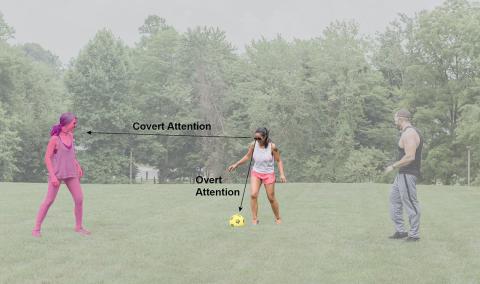Peripheral Vision Study Yields Clues About Brain Systems for Attention

Photo: NEI
Minuscule involuntary eye movements, known as microsaccades, can occur even while staring at a fixed point in space. When paying attention to something in the peripheral vision (called covert attention), these microsaccades sometimes align toward the object of interest.
New research by NEI investigators shows that while these microsaccades seem to boost or diminish the strength of the brain signals underlying attention, the eye movements are not drivers of those brain signals.
Scientists working on the neuroscience of attention have recently become concerned that because both attention and eye movements, like microsaccades, involve the same groups of neurons in the brain, that microsaccades might be required for shifting attention.
“This work shows that while microsaccades and attention do share some mechanisms, covert attention is not driven by eye movements,” said senior study author Dr. Richard Krauzlis of NEI.
Krauzlis’s previous research has shown that covert attention causes a modulation of certain neuronal signals in an evolutionarily ancient area of the brain called the superior colliculus, which is involved in detecting events.
When attention is focused on a particular area–for example, the right side of one’s peripheral vision–signals in the superior colliculus relating to events that occur in that area will receive an extra boost, while signals relating to events occurring elsewhere will be depressed.
When something shows up in our peripheral vision, we quickly shift our eyes–make a large saccade toward the event to take a better look. In laboratory studies of covert attention, primates or people are directed to avoid those types of large saccades, keeping the attended event in the peripheral vision. However, involuntary microsaccades often occur anyway.
In this study, the researchers trained monkeys to hold their eyes straight ahead, while attending to their peripheral vision by flashing a ring on the “cued” side. After the cue, the monkeys would release a joystick if they detected a color change on the cued side, while ignoring any color changes on the other side.
At the same time, researchers used high-resolution eye-tracking cameras to measure microsaccades during the trials. In essence, although the eye movement would also trigger changes to neuronal signals in the superior colliculus, attention-related signals occurred independently of the eye movement signals.
Findings from this NEI-funded study will help researchers may open new areas for research into attention disorders and behavior.
